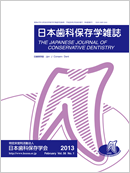Volume 53, Issue 2
Displaying 1-14 of 14 articles from this issue
- |<
- <
- 1
- >
- >|
Original Articles
-
Article type: Original Articles
2010 Volume 53 Issue 2 Pages 99-105
Published: April 30, 2010
Released on J-STAGE: March 29, 2018
Download PDF (657K) -
Article type: Original Articles
2010 Volume 53 Issue 2 Pages 106-114
Published: April 30, 2010
Released on J-STAGE: March 29, 2018
Download PDF (1041K) -
Article type: Original Articles
2010 Volume 53 Issue 2 Pages 115-122
Published: April 30, 2010
Released on J-STAGE: March 29, 2018
Download PDF (985K) -
Article type: Original Articles
2010 Volume 53 Issue 2 Pages 123-132
Published: April 30, 2010
Released on J-STAGE: March 29, 2018
Download PDF (987K) -
Article type: Original Articles
2010 Volume 53 Issue 2 Pages 133-139
Published: April 30, 2010
Released on J-STAGE: March 29, 2018
Download PDF (868K) -
Article type: Original Articles
2010 Volume 53 Issue 2 Pages 140-146
Published: April 30, 2010
Released on J-STAGE: March 29, 2018
Download PDF (879K) -
Article type: Original Articles
2010 Volume 53 Issue 2 Pages 147-158
Published: April 30, 2010
Released on J-STAGE: March 29, 2018
Download PDF (1351K) -
Article type: Original Articles
2010 Volume 53 Issue 2 Pages 159-165
Published: April 30, 2010
Released on J-STAGE: March 29, 2018
Download PDF (11779K) -
Article type: Original Articles
2010 Volume 53 Issue 2 Pages 166-173
Published: April 30, 2010
Released on J-STAGE: March 29, 2018
Download PDF (11679K) -
Article type: Original Articles
2010 Volume 53 Issue 2 Pages 174-181
Published: April 30, 2010
Released on J-STAGE: March 29, 2018
Download PDF (13609K) -
Article type: Original Articles
2010 Volume 53 Issue 2 Pages 182-190
Published: April 30, 2010
Released on J-STAGE: March 29, 2018
Download PDF (1044K) -
Article type: Original Articles
2010 Volume 53 Issue 2 Pages 191-206
Published: April 30, 2010
Released on J-STAGE: March 29, 2018
Download PDF (2171K) -
Article type: Original Articles
2010 Volume 53 Issue 2 Pages 207-213
Published: April 30, 2010
Released on J-STAGE: March 29, 2018
Download PDF (7416K) -
Article type: Original Articles
2010 Volume 53 Issue 2 Pages 214-221
Published: April 30, 2010
Released on J-STAGE: March 29, 2018
Download PDF (10378K)
- |<
- <
- 1
- >
- >|
